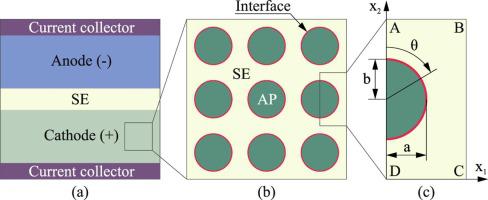当前位置:
X-MOL 学术
›
Comp. Mater. Sci.
›
论文详情
Our official English website, www.x-mol.net, welcomes your feedback! (Note: you will need to create a separate account there.)
Microscale diffusion-mechanics model for a polymer-based solid-state battery cathode
Computational Materials Science ( IF 3.3 ) Pub Date : 2021-01-01 , DOI: 10.1016/j.commatsci.2020.109990 Leyla Sultanova , Łukasz Figiel
Computational Materials Science ( IF 3.3 ) Pub Date : 2021-01-01 , DOI: 10.1016/j.commatsci.2020.109990 Leyla Sultanova , Łukasz Figiel

|
Abstract A non-linear microscale diffusion-mechanics model combining mass transport and linear momentum balance equations, with elasto-viscoplastic polymer constitutive law and interfacial traction-separation law is proposed to provide a new insight into the effects of viscoplasticity and interfacial damage on the in situ diffusive-mechanical behaviour of a polymer-based cathode for a solid-state battery (SSB). Diffusion and mechanics are coupled through two mechanisms: (1) active particle (AP) volumetric change dependence on Li concentration, and (2) interfacial flux dependence on mechanical opening. The model is resolved for a simple cathode microstructure using an axisymmetric unit cell concept, and integrated with the non-linear finite-element solver ABAQUS with the help of its user subroutines (UMAT and UINTER). Finite-element simulations reveal that plastic deformations of the polymer due to volumetric changes of the AP reduce the value of the interfacial opening displacement, which is desirable for maintaining interfacial flux. The results also demonstrate that slower battery charging rates may lead to a softer polymer response, and thus a smaller interfacial gap. Moreover, a comparison between the linear elastic and current elasto-viscoplastic models for the polymer electrolyte shows that even 5% volumetric shrinkage of the AP leads to an overprediction of the interfacial opening with the linear elastic material law, which limits its validity in modelling polymer-based SSBs.
中文翻译:

基于聚合物的固态电池阴极的微尺度扩散力学模型
摘要 提出了一种结合质量输运和线性动量平衡方程、弹粘塑性聚合物本构律和界面牵引分离律的非线性微尺度扩散力学模型,以提供对粘塑性和界面损伤对中的影响的新见解。用于固态电池(SSB)的聚合物基阴极的原位扩散机械行为。扩散和力学通过两种机制耦合:(1)活性粒子(AP)体积变化依赖于锂浓度,以及(2)界面通量依赖于机械开口。该模型使用轴对称单元概念求解简单的阴极微结构,并在其用户子程序(UMAT 和 UINTER)的帮助下与非线性有限元求解器 ABAQUS 集成。有限元模拟表明,由于 AP 的体积变化导致聚合物的塑性变形降低了界面开口位移的值,这对于保持界面通量是可取的。结果还表明,较慢的电池充电速率可能会导致聚合物响应较软,从而导致界面间隙较小。此外,聚合物电解质的线性弹性模型和当前弹粘塑性模型之间的比较表明,即使 AP 的体积收缩 5% 也会导致对线性弹性材料定律的界面开口的高估,这限制了其在聚合物建模中的有效性基于 SSB。这对于保持界面通量是可取的。结果还表明,较慢的电池充电速率可能会导致聚合物响应较软,从而导致界面间隙较小。此外,聚合物电解质的线性弹性模型和当前弹粘塑性模型之间的比较表明,即使 AP 的体积收缩 5% 也会导致对线性弹性材料定律的界面开口的高估,这限制了其在聚合物建模中的有效性基于 SSB。这对于保持界面通量是可取的。结果还表明,较慢的电池充电速率可能会导致聚合物响应较软,从而导致界面间隙较小。此外,聚合物电解质的线性弹性模型和当前弹粘塑性模型之间的比较表明,即使 AP 的体积收缩 5% 也会导致对线性弹性材料定律的界面开口的高估,这限制了其在聚合物建模中的有效性基于 SSB。
更新日期:2021-01-01
中文翻译:

基于聚合物的固态电池阴极的微尺度扩散力学模型
摘要 提出了一种结合质量输运和线性动量平衡方程、弹粘塑性聚合物本构律和界面牵引分离律的非线性微尺度扩散力学模型,以提供对粘塑性和界面损伤对中的影响的新见解。用于固态电池(SSB)的聚合物基阴极的原位扩散机械行为。扩散和力学通过两种机制耦合:(1)活性粒子(AP)体积变化依赖于锂浓度,以及(2)界面通量依赖于机械开口。该模型使用轴对称单元概念求解简单的阴极微结构,并在其用户子程序(UMAT 和 UINTER)的帮助下与非线性有限元求解器 ABAQUS 集成。有限元模拟表明,由于 AP 的体积变化导致聚合物的塑性变形降低了界面开口位移的值,这对于保持界面通量是可取的。结果还表明,较慢的电池充电速率可能会导致聚合物响应较软,从而导致界面间隙较小。此外,聚合物电解质的线性弹性模型和当前弹粘塑性模型之间的比较表明,即使 AP 的体积收缩 5% 也会导致对线性弹性材料定律的界面开口的高估,这限制了其在聚合物建模中的有效性基于 SSB。这对于保持界面通量是可取的。结果还表明,较慢的电池充电速率可能会导致聚合物响应较软,从而导致界面间隙较小。此外,聚合物电解质的线性弹性模型和当前弹粘塑性模型之间的比较表明,即使 AP 的体积收缩 5% 也会导致对线性弹性材料定律的界面开口的高估,这限制了其在聚合物建模中的有效性基于 SSB。这对于保持界面通量是可取的。结果还表明,较慢的电池充电速率可能会导致聚合物响应较软,从而导致界面间隙较小。此外,聚合物电解质的线性弹性模型和当前弹粘塑性模型之间的比较表明,即使 AP 的体积收缩 5% 也会导致对线性弹性材料定律的界面开口的高估,这限制了其在聚合物建模中的有效性基于 SSB。


























 京公网安备 11010802027423号
京公网安备 11010802027423号